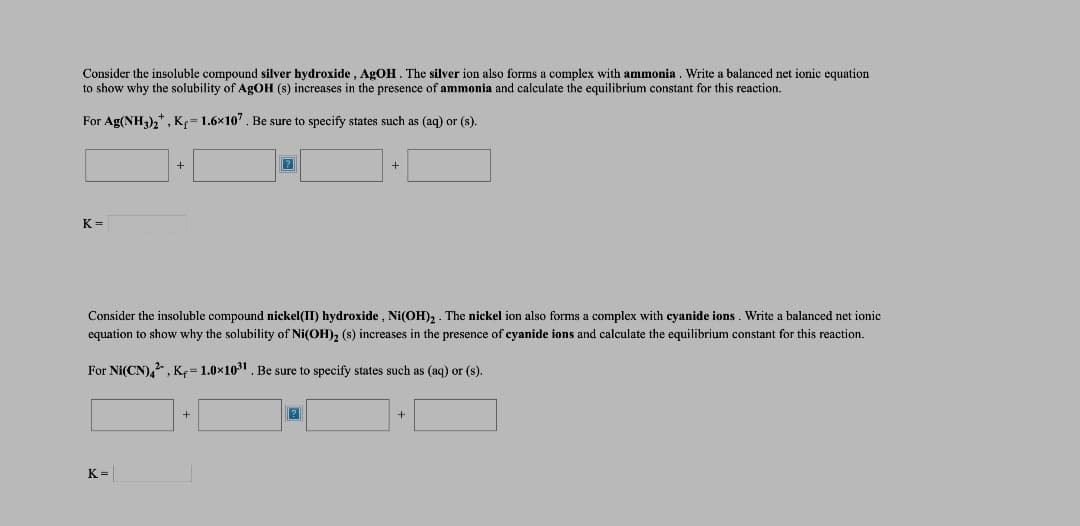Consider the insoluble compound silver hydroxide , AGOH. The silver ion also forms a complex with ammonia. Write a balanced net ionic equation to show why the solubility of AgOH (s) increases in the presence of ammonia and calculate the equilibrium constant for this reaction. For Ag(NH),*, K = 1.6x10. Be sure to specify states such as (aq) or (s). + K= Consider the insoluble compound nickel(II) hydroxide, Ni(OH), . The nickel ion also forms a complex with cyanide ions. Write a balanced net ionic equation to show why the solubility of Ni(OH), (s) increases in the presence of cyanide ions and calculate the equilibrium constant for this reaction. For Ni(CN),, K, = 1.0x101. Be sure to specify states such as (aq) or (s). K=
Consider the insoluble compound silver hydroxide , AGOH. The silver ion also forms a complex with ammonia. Write a balanced net ionic equation to show why the solubility of AgOH (s) increases in the presence of ammonia and calculate the equilibrium constant for this reaction. For Ag(NH),*, K = 1.6x10. Be sure to specify states such as (aq) or (s). + K= Consider the insoluble compound nickel(II) hydroxide, Ni(OH), . The nickel ion also forms a complex with cyanide ions. Write a balanced net ionic equation to show why the solubility of Ni(OH), (s) increases in the presence of cyanide ions and calculate the equilibrium constant for this reaction. For Ni(CN),, K, = 1.0x101. Be sure to specify states such as (aq) or (s). K=
Chemistry: The Molecular Science
5th Edition
ISBN:9781285199047
Author:John W. Moore, Conrad L. Stanitski
Publisher:John W. Moore, Conrad L. Stanitski
Chapter12: Chemical Equilibrium
Section: Chapter Questions
Problem 92QRT
Related questions
Question

Transcribed Image Text:Consider the insoluble compound silver hydroxide , AGOH. The silver ion also forms a complex with ammonia . Write a balanced net ionic equation
to show why the solubility of AGOH (s) increases in the presence of ammonia and calculate the equilibrium constant for this reaction.
For Ag(NH),*, Kp= 1.6x10". Be sure to specify states such as (aq) or (s).
+
+
K =
Consider the insoluble compound nickel(II) hydroxide , Ni(OH), . The nickel ion also forms a complex with cyanide ions. Write a balanced net ionic
equation to show why the solubility of Ni(OH), (s) increases in the presence of cyanide ions and calculate the equilibrium constant for this reaction.
For Ni(CN),, K =1.0×1031. Be sure to specify states such as (aq) or (s).
K =
Expert Solution
This question has been solved!
Explore an expertly crafted, step-by-step solution for a thorough understanding of key concepts.
This is a popular solution!
Trending now
This is a popular solution!
Step by step
Solved in 2 steps with 1 images

Knowledge Booster
Learn more about
Need a deep-dive on the concept behind this application? Look no further. Learn more about this topic, chemistry and related others by exploring similar questions and additional content below.Recommended textbooks for you

Chemistry: The Molecular Science
Chemistry
ISBN:
9781285199047
Author:
John W. Moore, Conrad L. Stanitski
Publisher:
Cengage Learning

Chemistry for Engineering Students
Chemistry
ISBN:
9781337398909
Author:
Lawrence S. Brown, Tom Holme
Publisher:
Cengage Learning

Chemistry & Chemical Reactivity
Chemistry
ISBN:
9781133949640
Author:
John C. Kotz, Paul M. Treichel, John Townsend, David Treichel
Publisher:
Cengage Learning

Chemistry: The Molecular Science
Chemistry
ISBN:
9781285199047
Author:
John W. Moore, Conrad L. Stanitski
Publisher:
Cengage Learning

Chemistry for Engineering Students
Chemistry
ISBN:
9781337398909
Author:
Lawrence S. Brown, Tom Holme
Publisher:
Cengage Learning

Chemistry & Chemical Reactivity
Chemistry
ISBN:
9781133949640
Author:
John C. Kotz, Paul M. Treichel, John Townsend, David Treichel
Publisher:
Cengage Learning

Chemistry & Chemical Reactivity
Chemistry
ISBN:
9781337399074
Author:
John C. Kotz, Paul M. Treichel, John Townsend, David Treichel
Publisher:
Cengage Learning

Introductory Chemistry: A Foundation
Chemistry
ISBN:
9781285199030
Author:
Steven S. Zumdahl, Donald J. DeCoste
Publisher:
Cengage Learning

Principles of Modern Chemistry
Chemistry
ISBN:
9781305079113
Author:
David W. Oxtoby, H. Pat Gillis, Laurie J. Butler
Publisher:
Cengage Learning